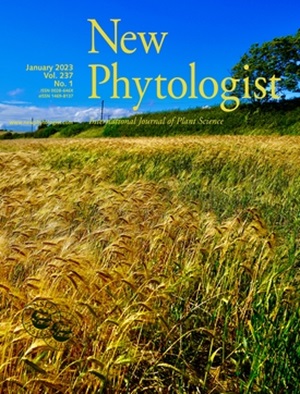Conserved phosphoserine/threonine-binding proteins in phloem-feeding insect saliva suppress plant defenses by attenuating the transactivation activity of ABI5.
IF 8.1
1区 生物学
Q1 PLANT SCIENCES
引用次数: 0
Abstract
Phosphoserine/threonine-binding proteins from the 14-3-3 class are involved in a variety of regulatory processes in all eukaryotic cells, including yeast, protozoa and mammals. Recently, 14-3-3 proteins have been identified in the saliva of some phloem-feeding insects, but their function remains poorly understood. 14-3-3 protein, secreted by the phloem-feeding whitefly Bemisia tabaci (Bt14-3-3), is delivered into tobacco plants during feeding. Within the plant, Bt14-3-3 interacts with the tobacco abscisic acid-insensitive 5-like (ABI5) basic leucine zipper transcription factor, repressing its ability to bind cis-acting activating elements present in the promoter region of the plant defensin J1-2 (PDF1.2) gene. Downregulation of PDF1.2 expression suppresses plant defenses, leading to enhanced whitefly performance. A homologous 14-3-3 protein secreted by the phloem-feeding aphid Myzus persicae was found to similarly enhance aphid performance on tobacco plants by interfering with the ability of ABI5 to transactivate the PDF1.2 gene. These results raise the possibility that during the evolutionary 'arms-race' between plants and phloem-feeding insects, 14-3-3 proteins present in the insects' saliva might have evolved novel functions that contribute to the ability of these insects to counterbalance their host plant defenses, transforming them into a suitable habitat for feeding and reproduction.取食韧皮部的昆虫唾液中保守的磷丝氨酸/苏氨酸结合蛋白通过降低ABI5的反活化活性来抑制植物防御。
14-3-3类的磷丝氨酸/苏氨酸结合蛋白参与了包括酵母、原生动物和哺乳动物在内的所有真核细胞的多种调节过程。近年来,在一些以韧皮部为食的昆虫的唾液中发现了14-3-3蛋白,但其功能尚不清楚。14-3-3蛋白由取食韧皮部的粉虱(Bt14-3-3)分泌,在取食过程中被输送到烟草植株中。在植物体内,Bt14-3-3与烟草脱落酸不敏感5-like (ABI5)碱性亮氨酸拉链转录因子相互作用,抑制其结合植物防御素J1-2 (PDF1.2)基因启动子区域的顺式激活元件的能力。PDF1.2表达下调可抑制植物防御,从而提高粉虱的生产性能。以韧皮部为食的桃蚜(Myzus persicae)分泌的一种同源14-3-3蛋白通过干扰ABI5反激活PDF1.2基因的能力,同样提高了蚜虫对烟草的抗性。这些结果提出了一种可能性,即在植物和以韧皮部为食的昆虫之间的进化“军备竞赛”中,昆虫唾液中存在的14-3-3蛋白可能进化出了新的功能,这些功能有助于这些昆虫抵消宿主植物防御的能力,将它们转化为适合觅食和繁殖的栖息地。
本文章由计算机程序翻译,如有差异,请以英文原文为准。
求助全文
约1分钟内获得全文
求助全文
来源期刊

New Phytologist
生物-植物科学
自引率
5.30%
发文量
728
期刊介绍:
New Phytologist is an international electronic journal published 24 times a year. It is owned by the New Phytologist Foundation, a non-profit-making charitable organization dedicated to promoting plant science. The journal publishes excellent, novel, rigorous, and timely research and scholarship in plant science and its applications. The articles cover topics in five sections: Physiology & Development, Environment, Interaction, Evolution, and Transformative Plant Biotechnology. These sections encompass intracellular processes, global environmental change, and encourage cross-disciplinary approaches. The journal recognizes the use of techniques from molecular and cell biology, functional genomics, modeling, and system-based approaches in plant science. Abstracting and Indexing Information for New Phytologist includes Academic Search, AgBiotech News & Information, Agroforestry Abstracts, Biochemistry & Biophysics Citation Index, Botanical Pesticides, CAB Abstracts®, Environment Index, Global Health, and Plant Breeding Abstracts, and others.
 求助内容:
求助内容: 应助结果提醒方式:
应助结果提醒方式:


